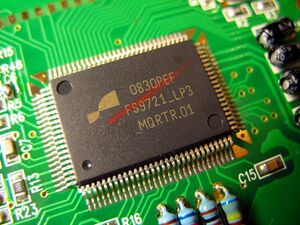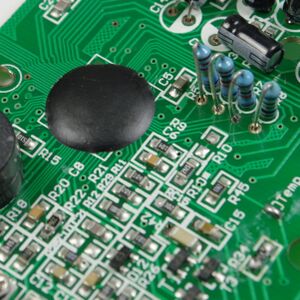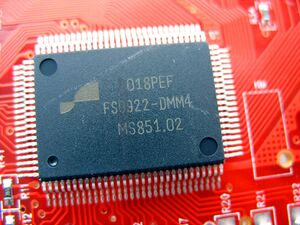Multimeter ICs
This page lists some information about ICs commonly used in various multimeters (DMMs).
Overview
Many multimeters use a special-purpose multimeter IC internally. This table lists those chips, as they're often directly responsible for the protocol and data format of the PC logging functionality of a multimeter.
| Vendor | Device | Builtin PC interface | Comments |
|---|---|---|---|
| Cyrustek | ES51922 | RS232, TX only, 19230 baud, 7o1 | Data is sent via the SDO pin. Data logging can be en/disabled via RS232 pin. |
| Fortune Semiconductor | FS9721_LP3 | RS232, TX only, 2400 baud, 8n1 | Data is sent via the TXD pin. Data logging can be en/disabled via ENTX pin. |
| Fortune Semiconductor | FS9922_DMM4 | RS232, TX only, 2400 baud, 8n1 (?) | Data is sent via the TXD pin. Data logging can be en/disabled via TXEN pin (?) and the REL/RS232 pin (?). |
| Intersil | ICL7106 | ? | |
| Intersil | ICL7136 | ? | |
| Intersil | ICL7139/ICL7149 | none (?) | |
| MASTECH | M343-01 | ? | |
| Maxim | MAX130/131 | ? | |
| Maxim | MAX133/134 | ? | |
| Metex | KS57C2016 | ? | Possibly a relabel'd Samsung KS57C2016 4-bit microcontroller. |
| New Japan Radio | NJU9207 | none |
Fortune Semiconductor FS9721_LP3


Protocol
The chip periodically sends 14-byte packets at 2400 baud, 8n1. The upper nibble of each byte indicates the byte number. The payload is composed of the lower nibbles, and is a 1-1 mapping of the LCD segments. The downside to this protocol structure is that transmission errors in the LSB nibbles cannot be detected. There is no checksum or CRC in the packet.
Packet structure:
| Byte | Bits 7-4 | Bit 3 | Bit 2 | Bit 1 | Bit 0 |
|---|---|---|---|---|---|
| 0 | 0x1 | AC | DC | Auto | RS232 |
| 1 | 0x2 | Negative | 1A | 1B | 1C |
| 2 | 0x3 | 1D | 1E | 1F | 1G |
| 3 | 0x4 | DP1 | 2A | 2B | 2C |
| 4 | 0x5 | 2D | 2E | 2F | 2G |
| 5 | 0x6 | DP2 | 3A | 3B | 3C |
| 6 | 0x7 | 3D | 3E | 3F | 3G |
| 7 | 0x8 | DP3 | 4A | 4B | 4C |
| 8 | 0x9 | 4D | 4E | 4F | 4G |
| 9 | 0xa | u | n | k | Diode |
| 10 | 0xb | m | % | M | Beep |
| 11 | 0xc | Farads | Ohms | Rel | Hold |
| 12 | 0xd | A | V | Hz | Low battery |
| 13 | 0xe | User bit 3 | User bit 2 | User bit 1 | User bit 0 |
Segment lettering:
| C | ||
| B | G | |
| F | ||
| A | E | |
| D |
Fortune Semiconductor FS9721B
TODO.
Fortune Semiconductor FS9922-DMM3
TODO.
Fortune Semiconductor FS9922-DMM4

The Fortune Semiconductor FS9922-DMM4 (datasheet) is a widely used 6000-count auto-ranging DMM chip: it takes input from the various controls on the front panel, drives the LCD display, and can communicate its readings via a serial port.
Protocol
TODO
Metex KS57C2016
TODO
Protocol
The protocol is briefly documented in various user manuals of DMMs using this IC.
- Serial port settings: 600 or 1200 baud, 7n2, RTS low, DTR high
- Every time the host sends a (any?) character to the DMM (most software sends a D/0x44), it returns 14 ASCII bytes containing the measurement mode, value, and units. Even with continuous packet requests, the IC will only send a packet when a new measuremet is available.
Packet structure
| Byte(s) | Description |
|---|---|
| 1-2 | Measuring mode (DC, AC, OH, CA, TE, DI, ...) |
| 3 | Always a space (?) |
| 4 | Sign ('-' or ' ', i.e. a minus or a space) |
| 5-9 | Decimal point and current measurement value (Examples: 10.00, 0L, 3.999) |
| 10-13 | Unit (Examples: V, mV, A, mA, kOhm, MOhm, nF, ...) |
| 14 | Carriage return (13/0x0d) |
Example packets
| 01 | 02 | 03 | 04 | 05 | 06 | 07 | 08 | 09 | 10 | 11 | 12 | 13 | 14 |
|---|---|---|---|---|---|---|---|---|---|---|---|---|---|
| D | C | - | 0 | 0 | 0 | . | 0 | V | \r | ||||
| A | C | 0 | 0 | . | 0 | 0 | A | \r | |||||
| C | A | 0 | . | 0 | 7 | 1 | n | F | \r | ||||
| O | H | O | . | L | M | O | h | m | \r |